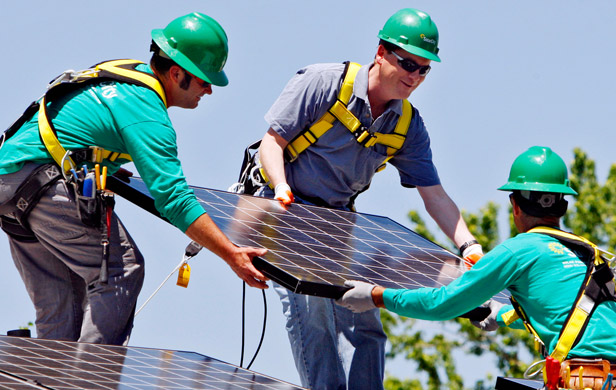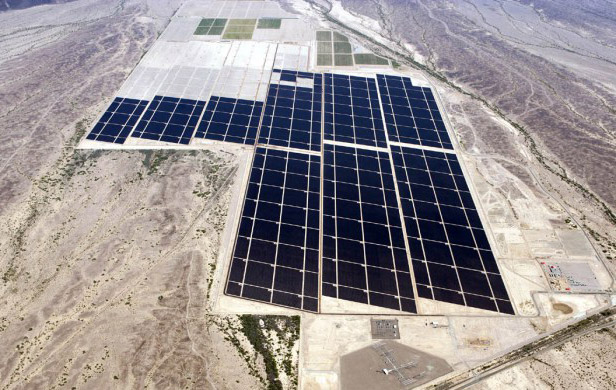
Listen to the rebuttals against opponents of oil pipelines, coal, and fracking and a familiar refrain emerges – it goes something like this:
[quote]It’s hypocritical to attack fossil fuels, because we all depend on them and will continue to do so well into the future.[/quote]
In other words, renewable energy is too pie-in-the-sky to solve our present energy challenges, so quit standing in the way of much-needed expansion to our fossil fuel infrastructure.
The problem is that this sort of thinking is based on where renewables were at a decade ago, ignoring the enormous, lightning-speed progress the sector has made – pretty much everywhere in the industrial world, except Canada.
Here are 6 reasons why renewable energy is the real deal:
1. Solar is really, really cheap now
The combination of advancements in photovoltaic technology and the mass-production of solar – with China leading the way – has contributed to a remarkable decline in the cost of solar. According to the Huffington Post:
[quote]In the last 35 years prices have gone from $77/ watt to around $.75/ watt. That makes solar 99 percent cheaper than it used to be. Since 2008, the cost of coal has risen 13 percent. In some parts of the market, solar has already reached parity with coal![/quote]
Ironically, the cost of solar has fallen so much that to some, it’s almost too cheap. China’s exports of low-cost solar technology have sparked trade tariffs from the US and Europe, each trying to protect their own booming clean tech industries.
China leapt from 1% of the global solar market in 2004 to a staggering 50% – of a much bigger market – by 2012, demonstrating the rapid scalability of the industry, given the right public policy and investment capital.
2. (Green) jobs, jobs, jobs
It used to be – and still is in some corners of the world, like Canada – that the argument for fossil fuels was all the jobs they create. Well, by far the biggest job opportunities today lie in the renewable sector, not oil and gas.
Europe currently boasts 3.5 million green jobs, adding 180,000/year from 1999-2008. That includes 1.2 million jobs in renewable energy, with 2.7 million projected for 2020.
According to innovation expert and Common Sense Canadian contributor Will Dubitsky:
[quote]In 2011, there were 372,000 people working in [Germany’s] clean energy sectors and the projections are such that these numbers are expected to be in the 400,000 to 500,000 range by 2020.[/quote]
Meanwhile, China has created 1.1 million jobs across its various solar sectors. The US – whose government invested $56 Billion in clean tech in 2012 (second only to China’s $68 Billion) – had generated 350,000 renewable energy jobs by 2012.
Around the world, close to 6.5 million jobs have been created in renewable energy – almost all of them in just the past decade – with the rate of growth only increasing.
3. The answer is blowing in the wind

Wind has also really taken flight in recent years – both in Europe and China. A major German study estimates that the actual cost of wind power is now lower than that of coal.
Many of us have heard about Germany and Denmark in the wind space (28% of Danish electricity comes from wind), but Spain has also become an overnight wind energy success story.
Greenhouse gas emissions from Spain’s power sector plummeted by 23% in 2013, with wind eclipsing nuclear and coal as the country’s number 1 source of electricity, at 21.1%. With increases in hydroelectricity and solar power, the majority of Spain’s electricity is now provided by renewable energy.
China, for its part, had generated 150,000 jobs in the wind sector by 2009, which is predicted to rise to half a million by 2020.
Now, a cautionary note about the cost of renewables, particularly in Europe, where we’re seeing a rise in “energy poverty”. In places like Germany and Spain, there is mounting criticism that policies directed toward promoting clean tech – such as feed-in-tariffs – are unnecessarily driving energy costs out of reach for less affluent consumers. This problem highlights the need to achieve an effective balance between renewable energy promotion and social equity. Certainly, higher power costs can help stimulate conservation, but there is a point where that can go too far, souring citizens on green energy.
In British Columbia, we’ve seen a rapacious private power industry win sweetheart contracts and force its costly electricity on citizens, under a false “green” label. Its large-scale river diversion projects have caused widespread ecological damage – without demonstrably reducing carbon emissions. Meanwhile, our provincial government is intent on flooding or disturbing over 30,000 acres of some of the country’s best farmland – which could feed a million people – for a $10 Billion, old-world, “clean” hydro dam.
But these are problems that affect any energy choices we make: questions of scale, cost, environmental benefits vs. trade-offs, and, importantly, fairness to the citizen and energy consumer. Policies that neglect these concerns will only hinder the potential of renewable energy in the long run.
4. America gets in the game
Besides China and Europe – the clear global leaders in the green economy – the US is catching up.
According to Will Dubitsky:
[quote]Renewable energy capacity in the US doubled in the 5 years from 2008 to 2012…Between 2007 and 2012, oil consumption as a percentage of total US energy consumption dropped from 39.3% to 36.7%. The consumption of coal also dropped from 22.5% of total US energy consumption in 2007 to 18.1% in 2012.[/quote]
Meanwhile, the world’s largest solar array was just completed in the desert outside of Phoenix, Arizona. The Agua Caliente plant is set to power up to 230,000 homes at its peak capacity of 290 megawatts.

According to Scientific American, the plant’s world record likely won’t last for long. “Other massive solar panel facilities, such as Antelope Valley Solar Ranch One in California’s Mojave Desert, are rapidly springing up across the Southwest.”
Adds Robert Margolis of the National Renewable Energy Laboratory, “This series of large plants that are being built really mark the transition from the technology being something experimental to real energy on the grid.” Scientific American expects to see solar’s contribution to the US electrical grid – currently just 1% – rise dramatically in the coming years.
All this renewable energy is already making a tangible impact on US greenhouse gases – with carbon dioxide emissions falling a sizeable 13% in the past 5 years – to levels not seen since 1994.
Finally, according to The Associated Press, American homes are getting much more efficient, sharply reducing their electrical consumption:
[quote]The average amount of electricity consumed in U.S. homes has fallen to levels last seen more than a decade ago, back when the smartest device in people’s pockets was a Palm pilot and anyone talking about a tablet was probably an archaeologist or a preacher.[/quote]
5. The Solutions are real
In spite of all of these examples of the miraculous growth of renewable energy, you may be thinking, “Yeah, but can it really replace fossil fuels?”
In a word, “Yes”.
I interviewed Professor Robert Howarth at Cornell University last week. Howarth is famous for changing the way we think about “natural” gas, demonstrating that fracking has a much higher carbon footprint than coal, as a result of “fugitive methane emissions” – small but persistent leaks of the potent greenhouse gas, throughout the extraction and transmission processes (methane can be up to 86 times more potent as a greenhouse gas than CO2, over a 20 year period).
The fact that these fugitive emissions are actually between 3.6% and 7.9% – much higher than previously thought – renders the terms “clean” or “natural” gas oxymorons, putting to bed the idea of gas as a “bridge fuel” (anything over 2.8% and gas is worse than coal).
But Howarth and a group of US Ivy League professors are doing much more than complaining about greenhouse gas-intensive fossil fuels. They are also the braintrust behind the “Solutions Project”, which is developing real, customized plans for each US state to get 100% off of fossil fuels by 2050. On their website, they show exactly how we could realistically get there.
For instance, the plan for Howarth’s home state of New York combines demand reduction with the following alternate energy mix:
- Offshore wind: 40%
- Solar photovoltaic (PV) plants: 15%
- Commercial/govt rooftop PV: 14%
- Onshore wind: 10%
- Hydroelectric: 7.5%
- Residential rooftop PV: 6.5%
- Geothermal: 5%
- Wave devices: 1%
- Tidal turbines: 1%
What’s more, the initiative is estimated to create 340,000 jobs, lasting 40 years, in construction and maintenance.
6. Nature backs clean tech
Forget about market signals – nature is sending its own message, loud and clear, about the urgency of converting to renewable energy.
The majority of these discussions happen with the vacuum of energy and economics – but every time a new report comes down from the International Panel on Climate Change, there is a far more compelling reason to make clean tech work. Even the White House is getting the message, releasing a new 800-page report last week that predicts severe climate impacts for the country. “This is not some distant problem of the future,” Obama told NBC on the report’s release.
Meanwhile, according to CNN, White House Office of Science and Technology Policy Director John Holdren said climate change “already is affecting every region of the country and key sectors of the economy.”
Canada misses boat on green jobs
Which brings us to my country, Canada. In a recent Vancouver speech surrounding a green economy conference, Robert F. Kennedy Jr. pointedly remarked that Canada used to be the world’s moral paradigm. But no more, under the Harper government’s aggressive, one-track fossil fuel regime.
The government’s fixation on fossil fuels is puzzling, given that job creation is the sole justification on which it hangs its hat. When the National Energy Board recommended in favour of the proposed Enbridge diluted bitumen pipeline from the Alberta oil/tar sands to the west coast, the only reason we were given was that it was in Canada’s economic “national interest”.
But, as we’ve observed in these pages, the evidence doesn’t support this dogmatic notion. On the contrary, Canada saw just 16,500 jobs created in the entire oil and gas sector from 2000-2011, while it shed 520,000 manufacturing jobs over the same period. Even Industry Canada acknowledges that something like a third of those manufacturing jobs were lost due to “resource-driven currency appreciation” (i.e. our petro-dollar is artificially high, thus hampering exports).
While our industrial counterparts are investing tens of billions a year in renewable energy – and reaping the rewards with millions of green jobs – Canada slashed its entire “EcoEnergy” federal innovation budget for this year.
Subsidizing climate change
Yet we continue subsidizing fossil fuels – to the tune of $1.4 Billion/year or more, depending on how you calculate it. The International Institute for Sustainable Development pegs the figure at about $2.6 Billion annually.
It would seem that Canada is locked into a sort of self-fulfilling prophecy feedback loop. We tell ourselves we must invest in fossil fuels because that’s where all the jobs are…which is because we refuse to create jobs in alternate, sustainable sectors.
In BC, our big idea is liquefied natural gas (LNG), which we dare to label “clean”, even though it is one of the world’s least efficient, most climate-damaging forms of energy – wrought almost entirely from fracked shale gas, going forward.
The program promises to increase BC’s entire carbon footprint by 2-3 fold. But even warnings from the Liberal government’s own ministry staff fall on deaf ears. As to the “jobs” and windfall profits being touted, there is a mountain of solid economic data that suggests these are nothing more than pipe dreams.
Getting to zero
The necessary project of transitioning off of fossil fuels is no mean feat, to be sure. It requires a network of related solutions – reducing energy demand through public transit, urban density, more efficient homes, businesses, and machines; not only diverting fossil fuel subsidies to renewable energy, but pricing carbon effectively; finally, taking advantage of the amazing improvements and cost-reductions in renewable energy.
That and we’ll have to be willing to make a few sacrifices – but not the kind that necessarily diminish the richness or quality of our lives; in fact they may offer surprising improvements in these areas.
But we’ll only get there if we have the necessary public and political will. And that begins with no longer allowing governments and representatives of the fossil fuel industry to get away with tired, old cop-outs, like renewables are impractical for providing our future energy needs.
Renewable energy is no longer a joke, just like climate change is no laughing matter.
Let’s get on with it.


Too bad that the people running the show will either fail to read this, or choose to read it and turn to run the other way. It’s so frustrating to know that we could do so much better, but that the people in power are in thrall to fossil fuel industries and their monied representatives. Nonetheless, it’s good that you’re still saying what needs to be said, and I thank you for it.
Further on the rate of the increase in job numbers and in reference to the article’s mention of 6.5M jobs in renewables in 2013, the 2013 figures represent an incredible leap from 2012, the year that there were 5.7M employed in the sector.
Canada, as Damien correctly points out, is not participating in the global migration to a green economy. Worse still, the total amount of funding dedicated in the last Budget for clean tech innovation is $0. Since innovation is the pre-requisite for product development and manufacturing, the green gap between Canada and other developed nations grows significantly with every year of the Conservative reign.
Meanwhile Trudeau has taken positions in favour of tar sands export and against cap and trade. According to Trudeau, both of these positions are science-based and the latter policy on cap and trade is referenced as a reflection of the Aussie Conservative government’s cancelling of that country’s cap and trade scheme.
Canada has two parties speaking on behalf of Big Oil.
I love all this positive information and am a supporter of alternate fuels for sure. But nowhere in your very informative article do I see any alternate suggestions to driving our vehicles with their internal combustion engines. I live in a rural setting, and that means I have to drive all the time – just to get a litre of milk. I am also lower to mid income and cannot afford an electric car – yet. I suspect there are many, many Canadians in the same boat. It is a very positive step to be able to replace our industrial fuel needs and our housing fuel needs with alternate energy (wind, sun, waves….) but I think the biggest lift to get off of fossil fuels is going to come with a cheaper, reliable replacement for the common, 10 year old, $5000 car. THAT’s when we’ll see some serious tide-turning. In the meantime, I’ll do all I can to support the alternate fuel industry and will pass your article on. Thanks!
Thanks, Marianne. I do touch on alternatives to single occupant, internal combustion vehicles toward the end of the story.
“The necessary project of transitioning off of fossil fuels is no mean feat, to be sure. It requires a network of related solutions – reducing energy demand through public transit, urban density, more efficient homes, businesses, and machines; not only diverting fossil fuel subsidies to renewable energy, but pricing carbon effectively; finally, taking advantage of the amazing improvements and cost-reductions in renewable energy.”
Electric or hybrid vehicles, which are simply far more efficient – capturing the energy generated by baking, for instance – make more sense than the old-school gas guzzlers you allude to. But we’re better off reducing our need for sigle occupant vehicles altogether.
BC is lucky to have BC Hydro, public-owned (mostly) and 95% renewable, clean hydro power.
50,000 GW
Too bad we’re about to double or triple our carbon footprint through LNG exports, Hugh…Not to mention the fact we don’t count our coal exports as part of our carbon accounting.
B.C is a world class carbon whore. Bring us your dirty coal, we will export it for you. Ask us to build site C to power the tar sands expansion, we will do it for you. We will also provide that power to facilitate cheaper fracking and refining of gas. Ask us to provide highways for coal transport, we will do it for you.
Ask us to provide port facilities and pipeline approvals for carbon trafficking and we will do it for you. Ask us to deny huge wind power projects like the one in Hecate straight on the grounds that the delivered cost is too high and we will do it for you.
The list is very long, the attention to carbon trafficking scrupulous and the price for these services? Well that is the good part, these are free to the international carbon traffickers.
Just look at our flag, B.C is indeed the House of the Rising Sun.